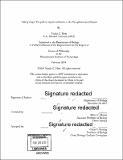| dc.contributor.advisor | Adam C. Martin. | en_US |
| dc.contributor.author | Heer, Natalie C. (Natalie Claire) | en_US |
| dc.contributor.other | Massachusetts Institute of Technology. Department of Biology. | en_US |
| dc.date.accessioned | 2018-05-23T16:29:54Z | |
| dc.date.available | 2018-05-23T16:29:54Z | |
| dc.date.copyright | 2018 | en_US |
| dc.date.issued | 2018 | en_US |
| dc.identifier.uri | http://hdl.handle.net/1721.1/115678 | |
| dc.description | Thesis: Ph. D., Massachusetts Institute of Technology, Department of Biology, 2018. | en_US |
| dc.description | Cataloged from PDF version of thesis. | en_US |
| dc.description | Includes bibliographical references. | en_US |
| dc.description.abstract | Creating biological form requires the generation of forces to rearrange tissues, as well as the patterning and organizational control of those forces to create the correct shapes. Force generation by actomyosin networks is a major driver of morphogenesis across many systems. The organization of actomyosin networks across multiple length scales is critical in generating biological form, including the Drosophila melanogaster ventral furrow. Using quantitative microscopy to measure the pattern of transcription, signaling, myosin activation, and cell shape in the Drosophila mesoderm, I found that cells within the ventral domain accumulate different amounts of active apical non-muscle myosin 2 depending on their distance from the ventral midline. This gradient in active myosin depends on a newly quantified gradient in upstream signaling proteins, including the transcription factor Twist. Experimental broadening of the myosin domain in vivo disrupts tissue curvature where active myosin is uniform. From this data, I argue that apical contractility gradients are important for tissue folding. Finally, I found that the gradient in active myosin is shaped by inhibitors of RhoA signaling downstream of the Twist gradient. This work improves our of understanding how actomyosin activity at the tissue level in the Drosophila ventral furrow is organized and how that organization impacts biological form. | en_US |
| dc.description.statementofresponsibility | by Natalie C. Heer. | en_US |
| dc.format.extent | 109 pages | en_US |
| dc.language.iso | eng | en_US |
| dc.publisher | Massachusetts Institute of Technology | en_US |
| dc.rights | MIT theses are protected by copyright. They may be viewed, downloaded, or printed from this source but further reproduction or distribution in any format is prohibited without written permission. | en_US |
| dc.rights.uri | http://dspace.mit.edu/handle/1721.1/7582 | en_US |
| dc.subject | Biology. | en_US |
| dc.title | Taking shape : the path to myosin activation in the Drosophila ventral furrow | en_US |
| dc.title.alternative | Path to myosin activation in the Drosophila ventral furrow | en_US |
| dc.type | Thesis | en_US |
| dc.description.degree | Ph. D. | en_US |
| dc.contributor.department | Massachusetts Institute of Technology. Department of Biology | |
| dc.identifier.oclc | 1036985595 | en_US |
